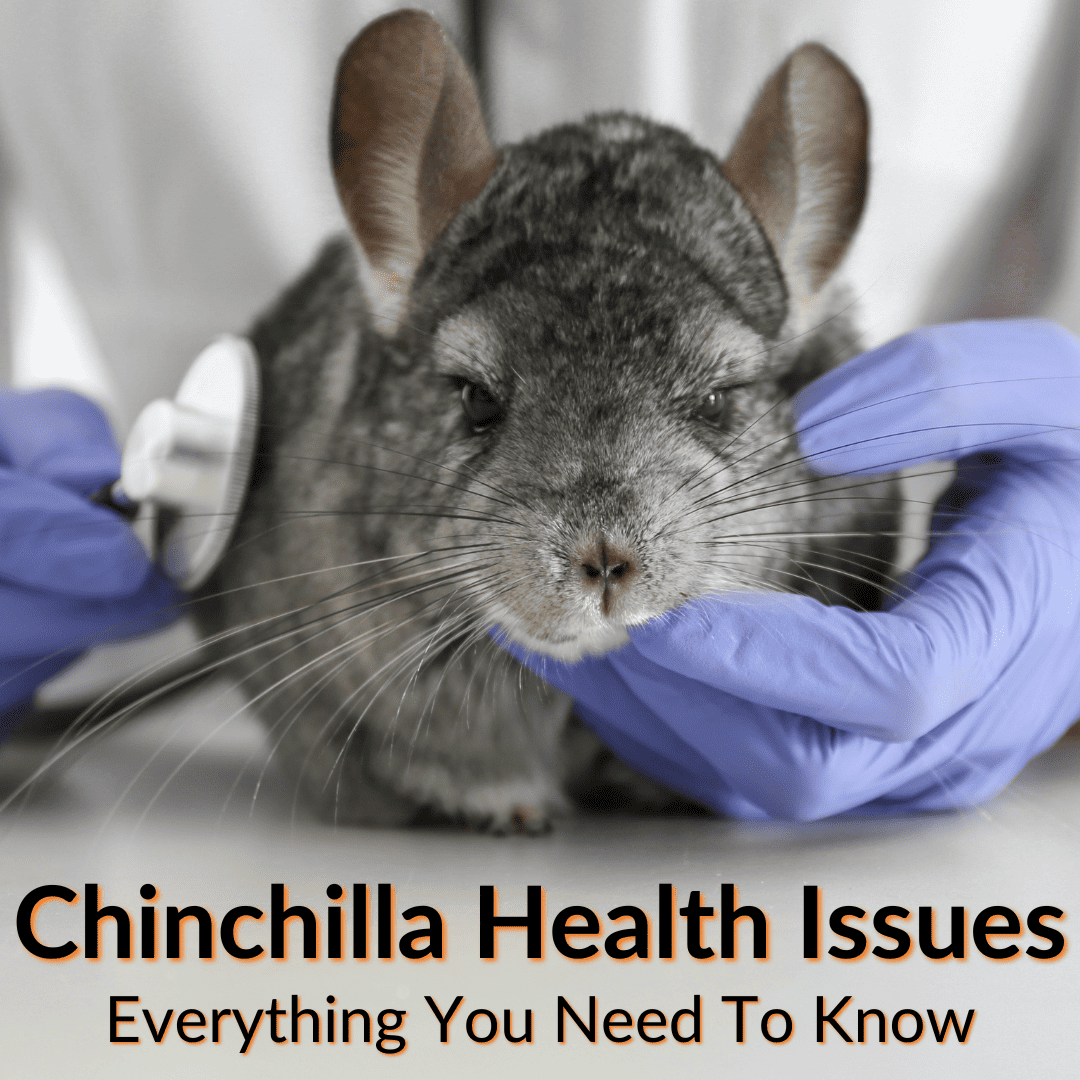
They don’t have as many common health problems as some other rodents.
That said, there are still some fairly common chinchilla health issues you need to know about.
Simple health problems can easily become fatal with such a small animal.
That’s why you want to recognize common health issues and know what to do if they occur.
Keep reading to learn just that. We will discuss the main health problems common in chinchillas and tell you how to recognize them, what to do about them and how to help prevent them from happening in the first place.
Contents
Chinchilla Health Issues
The following are all relatively common chinchilla health issues anyone caring for a chinchilla needs to know about. You want to be able to recognize them and know what to do if you notice any symptoms.
We’ll also show you what you can do to help minimize the chances of your chinchilla suffering from any of these health problems.
Respiratory Issues

When chinchillas get sick, respiratory issues are a common cause. They can’t catch a human cold, but they can get other respiratory diseases. And unfortunately, these diseases can quickly go from bad to worse, so getting prompt veterinary treatment is essential.
Symptoms
- Thick mucus-like discharge from eyes and nose
- Red eyes
- Wheezing/rattling/cracking sound while breathing–your pet’s chest might visibly widen and contract with each breath
- Sneezing with nasal discharge
- Dull hair coat–loss of softness and density
- Loss of appetite and weight loss
- Shaking or shivering
- Decreased activity
- Grumpiness–your chinchilla might leave its cage mate or humans with bite wounds
Causes
Poor housing conditions are usually one of the main culprits behind chinchilla respiratory issues. Also, bacteria such as Streptococcus are responsible for these diseases.
Your vet may take a sample of your chinchilla’s nasal discharge to diagnose the exact pathogen causing the infection. In some cases, chest X-rays may help determine the severity of pneumonia.
What To Do
It is important to take your chinchilla to the vet right away, as soon as you notice the above chinchilla respiratory infection symptoms. Chinchillas are tiny animals, and bacteria or viruses can quickly overwhelm their immune systems. What starts as a cold may quickly develop into pneumonia, so call your vet to make an appointment right away.
Tips For Prevention
Clean your pet’s cage regularly. Feed your pet a healthy diet. Encourage your pet to exercise and maintain a healthy weight. Minimize stress for your chinchilla.
Dental Issues
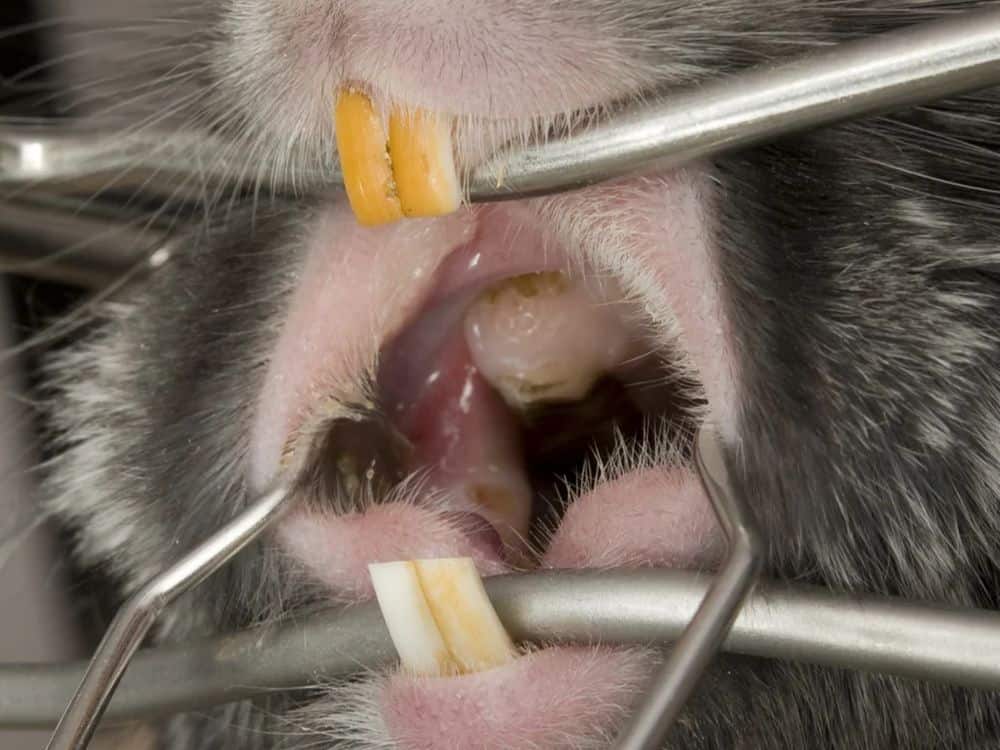
Chinchilla’s teeth grow continuously, and their rate of dental growth can only be balanced by the rate of wear. This can lead to a number of dental problems in chinchillas. One of the more common issues is malocclusion.
Symptoms
- Loss of appetite: your chinchilla’s food isn’t disappearing the way it used to
- Difficulty eating: your pet might avoid hard food and may spill more food than usual
- Excessive drooling: the fur around its mouth may be stained
- Weight loss: an obvious result of a loss of appetite or difficulty eating
- Foul odor: dental issues like abscesses can cause a foul odor around your chinchilla’s head
- Long, overgrown, or oddly angled teeth: you can examine your chinchilla for teeth that are chipped, broken, too long, or at an odd angle. Be careful not to get bitten.
Causes
The most common cause of dental issues in chinchillas is a lack of opportunity to wear the ever-growing teeth down. If you aren’t providing hay or grass along with wooden blocks and dental chews, then the teeth could grow at an alarming rate.
Genetic issues can also cause a malformation or misalignment of teeth in chinchillas. Good breeders refrain from breeding chinchillas with such dental issues.
What To Do
Take your chinchilla to the vet. They may sedate your chinchilla and use an otoscope to examine its incisors and molars. If your pet’s teeth are overgrown, the vet may use clippers to file them down.
During the recovery period, you need to feed a special diet to your chinchilla, including grated vegetables and soaked soft pellets.
Tips For Prevention
Feed your pet the right diet and provide appropriate dental chews. Regularly inspect your chinchilla for dental problems.
Gastrointestinal Stasis
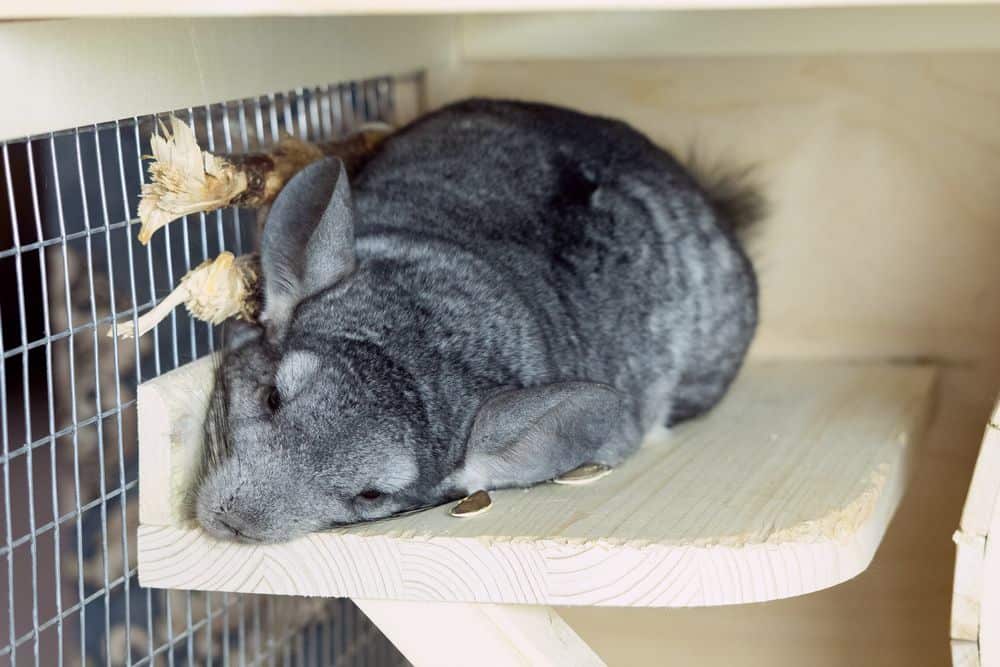
GI stasis is another common health problem in chinchillas. GI stasis in chinchillas occurs when the muscular contractions within the stomach and intestines stop or slow down, causing an imbalance in the microbiome.
Symptoms
- Changes in eating patterns
- Changes in fecal size, frequency, color, and consistency
- Decreased appetite
- Weight loss
- Decreased movement or lethargy
- Abdominal stretching or hunched posture
- Behavioral changes, including aggression
Causes
Gastrointestinal stasis in chinchillas can have several causes:
- Inflammation or infection
- Inappropriate diet (diets lacking fiber)
- Physical obstruction
What To Do
If you suspect GI stasis, take your chinchilla to the vet immediately. This is a life-threatening condition.
Your vet will order several tests, including x-rays and scans. Treatment may include oral or IV fluids, antibiotics, pain medicines, and gastric motility medicines.
For home care, you may need to feed your chinchilla a liquid diet for a few days. This may include syringe-feeding or hand-feeding as well.
Tips For Prevention
To prevent GI stasis, offer your chinchilla plenty of hay or grass daily. Limit your pet’s treats to 2% of its diet. Offer several varieties of hay/grass (timothy, orchard, etc.).
Bloat
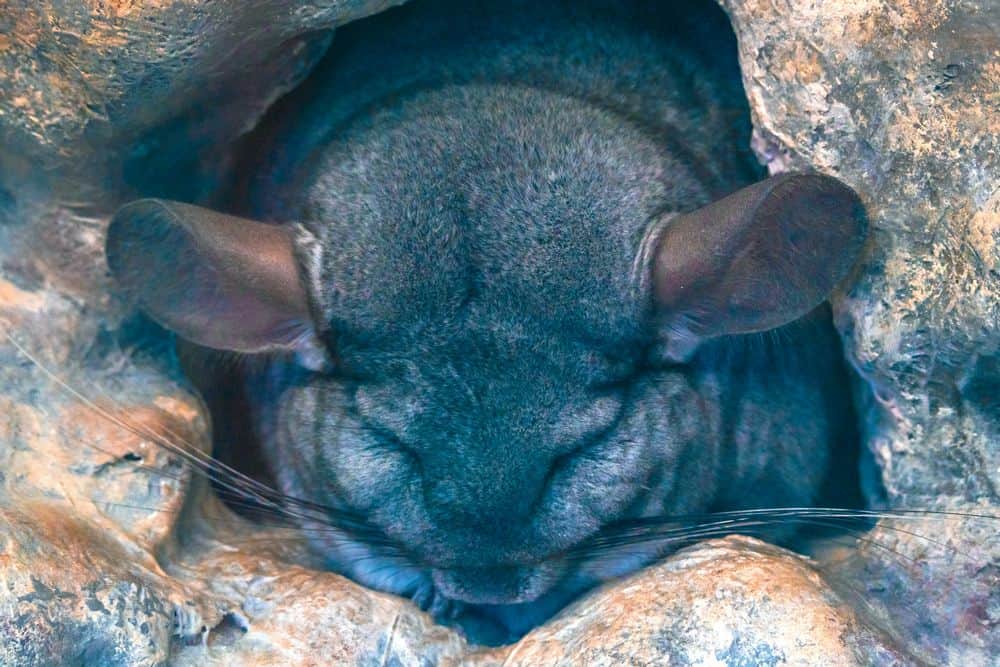
Gastric bloat is a life-threatening condition in chinchillas. It results in the stomach filling up with gas and fluids, resulting in death.
Symptoms
- Bloated, distended abdomen
- Decreased or no appetite
- Producing little to no feces
- Pain–hunched posture, grinding teeth
- Hiding, lethargy, and decreased activity
Causes
Bloat in chinchillas is usually caused by an obstruction in the outflow, which prevents fluids and food from leaving the stomach.
Since chinchillas cannot vomit and cannot fart, the accumulated fluids and food cannot leave the stomach, resulting in dilation. Eating objects like plastic or carpet can also cause a physical obstruction, resulting in bloat. In rare cases, a tumor, abscess, or hernia may be the cause.
What To Do
Rush your pet to the vet if you suspect bloat. Your vet may take X-rays and perform some blood tests.
Treatment includes gastric decompression by passing a tube from your chinchilla’s mouth into its stomach. Surgical intervention may also be needed in some cases. To prevent your chinchilla from getting dehydrated, the vet will start IV fluid replacement.
Once your chinchilla recovers, you need to feed it some gruel by grinding pellets with water.
Tips For Prevention
Provide your chinchilla with an appropriate diet of high-quality hay. Avoid overfeeding it with cereal and bread. Minimize obesity by encouraging your chinchilla to exercise. Also, reduce stressful conditions.
Diarrhea
Diarrhea in chinchillas can be intermittent (on/off) or constant. Constant diarrhea can be life-threatening. Ideally, you should not overlook both types of diarrhea in your chinchilla, since both indicate some health issues.
Symptoms
- Small, watery feces
- Liquid feces
- Foul odor
- Tummy rumbling sounds
- Lack of appetite
- Decreased water intake
- Lethargy
- Abdominal pain–hunched posture, hiding, rapid breathing, frequently changing body positions
Causes
- A diet lacking in fiber or roughage
- Infections (bacterial, viral, parasitic)
- Drugs or toxins
- Eating inappropriate food
What To Do
The vet might order fecal tests, blood tests, X-rays, or an abdominal ultrasound. Treatment may include dietary modification, fluids to prevent dehydration, antibiotics, deworming, pain medicines, and motility medicines.
Tips For Prevention
Provide a steady supply of high-quality grass or hay. Avoid changing your chinchilla’s brand of pellets abruptly. Maintain a consistent and balanced diet, and do not feed your pet a diet of just pellets. Get your new chinchillas examined bi-annually by your vet.
Skin Issues
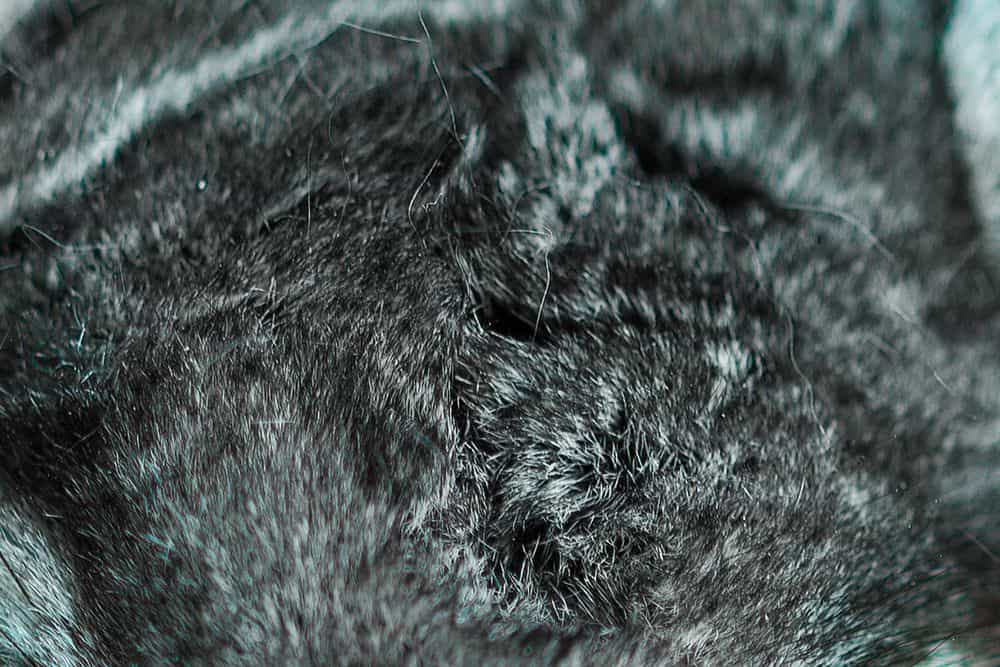
Your chinchilla’s skin and fur are important for its overall health and well-being. Skin issues can make your pet extremely uncomfortable.
Symptoms
- Itchy skin–you may notice your chinchilla scratching more than usual
- Hair loss
- Rashes, redness, and blisters
- Smelly skin
- Coat color changes
- Urine scald–burns on the bottom region
- Mites, parasites
- Wounds or abscesses
- Paw-related issues like bumblefoot (painful ulcers on the soles of the feet)
- Ringworm, a type of chinchilla ear fungus; it can occur anywhere though, not just the ears
Causes
Bacteria, viruses, fungi, and parasites, like lice, fleas or mites, can cause skin issues in chinchillas, like dry skin on the ears.
What To Do
Contact your vet. For certain skin issues, your vet might order some skin tests or blood work. Treatment usually includes topical and oral medicines. Some chinchilla skin issues may require medicated powders or sprays.
Tips For Prevention
Provide your chinchilla with regular dust baths. Feed it a healthy diet to strengthen its immunity. Change bedding regularly. Ensure that the floor of the cage is solid, since wire cages can cause bumblefoot. Deep clean the cage regularly with vet-approved cage cleaners to prevent unhygienic conditions.
Heat Stroke
You must treat heat strokes in chinchillas as an emergency. Failure to provide timely treatment can quickly turn fatal.
Symptoms
- Panting
- Open-mouthed breathing
- Increased body temperature
- Reluctance to move; lying on the side
- Red ears
Causes
Heat strokes in chinchillas usually occur due to improper ventilation and temperatures above 80° F (27° C).
What To Do
Take steps to cool down your pet right away. Provide a cool, well-ventilated, and preferably dark area for your chinchilla to rest. Provide fresh drinking water. Regularly check its body temperature. Once your chinchilla has recovered a bit, take it to the vet.
Tips For Prevention
Keep your pet’s water bottle filled. Place the cage away from direct sunlight. Avoid over-exerting your chinchilla in the warmer months. Keep humidity levels low.
Reproductive Issues
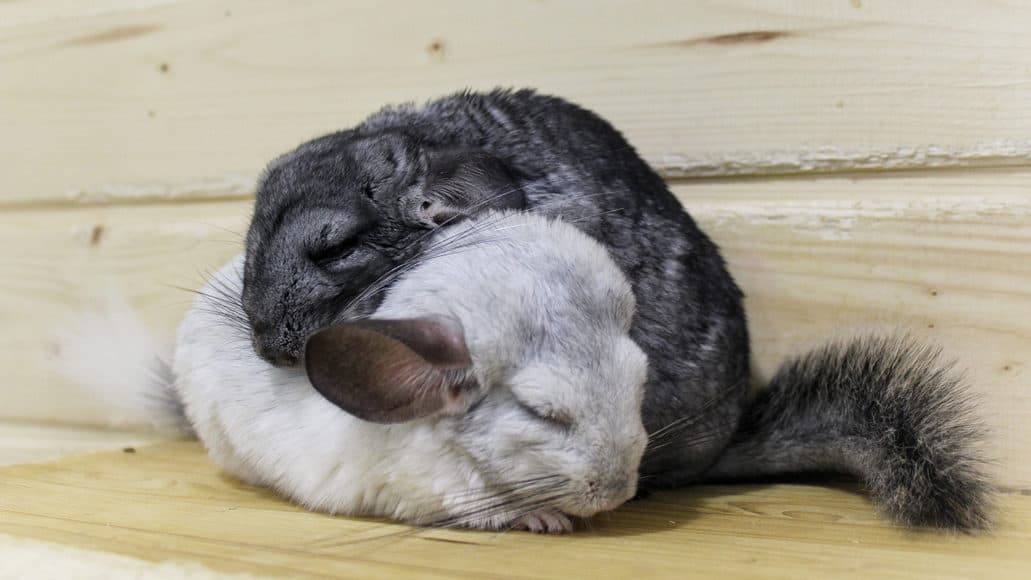
Chinchillas could develop various reproductive issues, including pyometra, infertility, metritis, mastitis, etc.
Symptoms
- Female chinchillas may develop vaginal discharge or swelling due to uterine tumors, pyometra, etc.
- Male chinchillas could develop hernias
- Both genders could suffer from papules, vesicles, crusting, or ulcers on the external genitalia
Causes
- Genetic or congenital abnormalities
- Infections
- Tumors
- Abnormal hormone production by the ovaries, testes, or adrenal glands
What To Do
See your vet right away.
Tips For Prevention
Provide your chin with a healthy, balanced diet. Prevent obesity by regularly exercising your chinchilla. If your vet recommends it, please have your pet spayed or neutered. Note that chinchilla neutering or spaying is a complicated surgery and is something you want to avoid in most cases.
Broken Bones
Broken legs in chinchillas can occur as a result of falls, accidents, or even improper handling.
Symptoms
- Immense pain
- Inability to move, especially the affected portion of its body
- Swelling around the area of the broken bone
- You may hear a crackling sound when the fractured area is manipulated, due to the broken ends of the bone rubbing against each other
Causes
- Fighting with another chinchilla
- Falls
- Rough handling or squeezing tightly
- Getting tangled in exercise wheel or wire-bottom cage
- Being stepped on
- A poor diet can contribute to weakened bones and make a chinchilla more vulnerable to fractures
What To Do
See your vet right away. Do not try to treat a broken bone yourself, unless you are experienced in doing so.
Tips For Prevention
Try to keep your pet’s cage as safe as possible. If the cage has a wire bottom, cover it with something to remove the risk of a broken leg from getting stuck between the bars. The same goes for ledges, ramps, and running wheels.
You should also chinchilla proof any area outside the cage where you let your pet play. Take care when handling your chinchilla, too. It is fairly easy to break a bone, since they are so small. And a broken leg could lead to chinchilla paralyzed rear legs.
Seizures
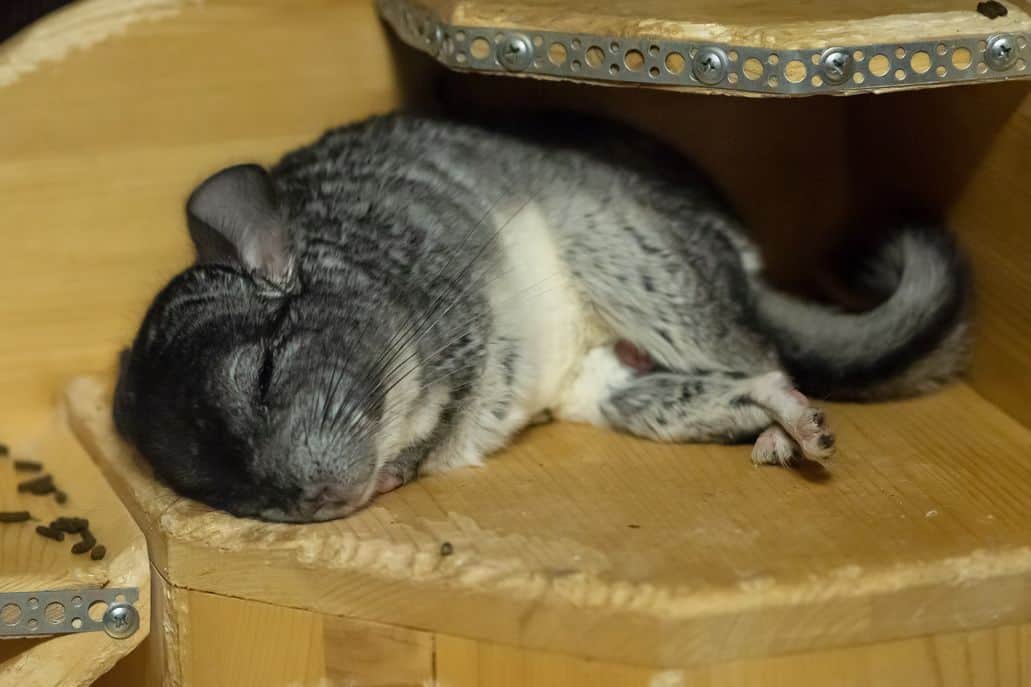
Chinchillas can suffer from seizures that can result from several causes. A seizure can be scary, but may not necessitate a vet visit. It is best to call your vet to see what they think about coming in.
Symptoms
- Spasms or twitching, like twitching of the nose
- Stiffening of the body
- Curling inward
- Laying on one side twitching uncontrollably
- Staggering
- Rigid posture with foot and mouth spasms
- Loss of consciousness
Causes
- Listeriosis
- Calcium or thiamine deficiency
- Head trauma
- Poisoning
- Heatstroke
- Hypoglycemia
- Genetic diseases
What To Do
During a seizure, it is important to move the chinchilla to ground level and remove any objects out of its way that can hurt it. A chinchilla seizure can last anything from a few seconds to a few minutes. If you suspect your chinchilla is having a seizure, it is important to consult with your veterinarian as soon as your pet is doing better. They may want to you to come in for a checkup, but not always.
Tips For Prevention
It is important to provide a safe and healthy environment for your chinchilla to prevent seizures. This includes providing a balanced and nutritious diet, keeping the chinchilla’s cage clean and free of harmful substances, and monitoring the chinchilla’s behavior for any signs of distress or illness.
Hair Ring
Hair ring is a common condition that occurs in male chinchillas. It is caused when loose fur becomes trapped on the sheath of a male chinchilla’s penis. When the penis retracts, the loose fur can knot and form a ring that circles the penis. This condition can cause pain, discomfort, and can even lead to serious health issues if left untreated.
Symptoms
- Difficulty urinating
- Lethargy
- Loss of appetite
- Pain or discomfort when urinating or retracting the penis
- Swelling or redness around the penis
- Inflammation or infection of the penis or surrounding area
- Blood in the urine
Causes
As mentioned, hair ring in chinchillas is caused by loose fur becoming trapped on the sheath of a male chinchilla’s penis. Factors that may contribute to hair ring in chinchillas include poor grooming habits, inadequate living conditions, and a lack of exercise.
What To Do
If you suspect your chinchilla has a hair ring, it is important to seek veterinary care as soon as possible. Treatment for hair ring typically involves removal of the hair ring by a veterinarian, which may require sedation. In some cases, they may also prescribe antibiotics to prevent infection.
Tips For Prevention
To prevent hair ring in your chinchilla, it is important to keep its living environment clean and dry, and to regularly groom it to prevent loose fur from accumulating on its body. You should also check your male chinchilla regularly for any signs of a hair ring beginning to form.
Eye Problems
Chinchillas can develop a variety of eye problems. Some common eye problems in chinchillas include:
- Conjunctivitis: An inflammation of the clear tissue that covers the white part of the eye and the inner side of the eyelids. It can be caused by an allergic reaction, bacterial or viral infections, or injury. Signs of conjunctivitis include red, swollen eyes, watery discharge, and discomfort.
- Corneal ulcers: A corneal ulcer is an open sore on the surface of the eye that can be caused by injury, infection, or other factors. Signs of a corneal ulcer include redness, discharge, and cloudiness of the eye.
- Eye infections: Chinchillas can develop bacterial, viral, or fungal infections of the eye, which can cause redness, discharge, and discomfort.
- Overgrown teeth: If a chinchilla’s teeth become overgrown, they can interfere with proper tear drainage, leading to watery eyes and discomfort.
Symptoms
- Watery eyes
- Redness or swelling around the eyes
- Discharge or crustiness around the eyes
- Cloudiness or opacity of the eye
- Squinting or rubbing of the eye
- Sensitivity to light
- Loss of appetite or lethargy
- Changes in behavior or mood
Causes
- Allergic reactions to environmental irritants, such as dust or pollen
- Bacterial, viral, or fungal infections
- Trauma or injury to the eye
- Overgrown teeth interfering with proper tear drainage
- Nutritional deficiencies, such as a lack of vitamin A
- Genetic predisposition to eye problems
- Aging or other underlying health issues
What To Do
If you notice any of these symptoms in your chinchilla, it is important to seek veterinary care as soon as possible to prevent further complications. Early detection and treatment of eye problems can help prevent serious health issues, as well as a lot of discomfort for your chinchilla.
Tips For Prevention
To prevent eye problems in chinchillas, it is important to keep their living environment clean and free of dust and other irritants. Providing your chinchilla with a balanced and nutritious diet can help promote overall health and help prevent dental problems that can contribute to eye issues. You pet needs plenty of things to chew on, too.
Chinchilla Sickness: Final Thoughts
All chinchilla health issues are serious. Even if it just seems like a little thing, it can quickly turn deadly. On the other hand, visits to the vet are stressful and can actually make your chinchilla sick themselves. It is best not to take your chinchilla to the vet often (they don’t need shots either).
As a result, it is always a balancing act. Do you rush your pet to the vet to be safe, or do you wait less serious health problems out, hoping they do not deteriorate and leave you dealing with a dead chinchilla? It is a decision with which all chinchilla owners struggle.
If you have a vet you trust, you can always call them whenever you pet is suffering from a health issue and give them all the details. Then your vet can decide whether it is best to bring your pet in for a checkup immediately, or whether it is better to wait a bit and see how things develop.
If you are worried about your pet passing diseases on to you, know that it is rare for chinchillas to carry zoonotic diseases. Even though they are rodents, chinchillas rarely have rabies, because a pet chinchilla should not come into contact with carriers, if you keep it indoors, as you should.
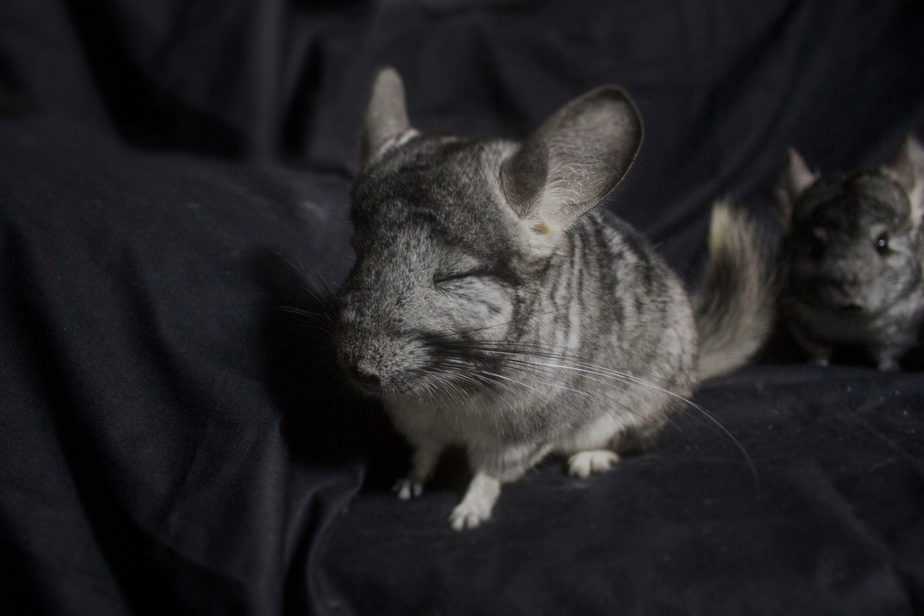
Leave a Reply